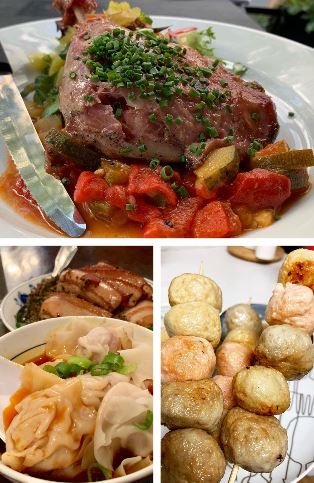Foodie Maricar Tangonan’s Best and Worst

By Cristina DC Pastor
Homesickness drove Maricar Tangonan, a first-timer in New York in 2005, to food. Exploring restaurants for almost 15 years now has transformed her into a fervent food enthusiast.
An Ilocana from Camiling, Tarlac, Maricar is a hardcore foodie. She eats out at least three times a week trying new restaurants and their specialty dishes. She is constantly keeping herself in-the-know on food trends. She follows the Michelin Guide religiously, hand-shakes the chefs whose food dazzle her, and posts reviews on Yelp where she is in the Elite club. On her Facebook, she describes a “passionate student of the world and her favorite specimen is food.”
She remembers her first time at Big Wong on Mott Street, her initiation into New York-style Cantonese cooking.
“On my first day in Manhattan, my auntie took me to Big Wong in Chinatown,” she recalled. “To this day, these Cantonese cooks are my friends who affectionately call me ‘Malical’ in their Chinese accents and let me order off-menu items.” Sharing meals on their 4 p.m. lunch breaks, she ate comfort food dishes eaten by the staff that are far different from the dishes on the menu.
“I love those meals where our main bond was the enjoyment of food as the staff barely spoke English,” she said.

One dining experience led to another and before she knew it, her taste repertoire has expanded beyond the Ilocano flavors of Pinakbet, Insarabasab and Binubudan. A craving for Spanish tapas brings her to the Michelin-starred Casa Mono by Union Square; Aquavit on 55th Street for inventive Nordic food; Neue Gallery’s Café Sabarsky on Fifth Avenue’s Museum Mile is her go-to place for a Viennese meal and some European art. For comfort food, it’s Nyonya for its Malaysian menu and friendly staff or the Thai eateries Ayada Thai and Hug Esan in Queens for Issan cuisine. The Issan region along the Thai-Lao-Cambodia border is noted for its use of fish sauce and hot chillies.
“When I moved to New York City from the Philippines, I dealt with my homesickness and culture shock through getting to know other cultures,” she told The FilAm. “The easiest and most enjoyable way is by eating other people’s food.”
Looking for a unique food experience, Maricar, a healthcare recruiter, prefers to dine solo or with a friend. “Exploration is best with just one or two diners. To me a great experience is when I go beyond what’s on the plate. For example, if a dish inspires more research about its culture, people, history and creator, I feel more fulfilled.”

She scouts for restaurants that have either “authentic comfort food” or “chef-driven creative menus,” especially those kitchen lords conscious about selecting highest quality ingredients. Quality of food is first and central to an experience, she said. “The combo of service and ambience is what makes customers keep coming back, but to me it’s secondary.”
Cleanliness is not high up there in her decision to check out a restaurant. She said, “I have eaten in the gutters of Vietnam and ate in the streets and countryside of Thailand where food preparation won’t likely pass Western standards.” She eats from halal carts of NYC, too, so sanitation is “really not a key thing.”
Recently she was ecstatic to try NYC places with hard-to-get seats such as Rezdora in Gramercy, Don Angie in the Greenwich Village, and Frenchette in Tribeca. Maricar enjoys a variety of cuisine from Japanese, Chinese, and Issan Thai food. Italian cooking, especially from the regions of Tuscany and Ligurian, is also a favorite along with German, Korean, and Jamaican.
“I research a lot about cuisines, dishes and the chefs – their food focus, inspiration, food aesthetics/philosophy,” she said. “I read reputable culinary reviews.”
“The worst are the restaurants in the Times Square or some touristy area that are usually not consistent and unreasonably expensive because their target customers are moneyed tourists who aren’t coming back. I advise friends who are visiting NYC to stay away from these establishments and explore places where locals actually eat,” she said.
How does Filipino food fare in her culinary expeditions?
“The best one for me is Bad Saint in Washington, D.C. It reimagines Philippine cuisine using local ingredients without compromising its flavor and authenticity,” she said.

She remembers lining up twice for this Bon Appetit’s Best New Restaurant in 2016, the first enduring more than three hours without successfully getting in because the line was too long. More determined and better prepared, she came back after a few months and was in line five hours before opening — in the cold of winter.
“If there is one Filipino restaurant that may have a chance to get a Michelin Star, this should be it.”
But that is not the longest she’s ever waited to be served. On the week that Jollibee opened in Queens in 2007, she held on to her spot for more than seven hours.
A chuckle for the memory: “I had to eat dinner while in line to get a table.”


© The FilAm 2019










